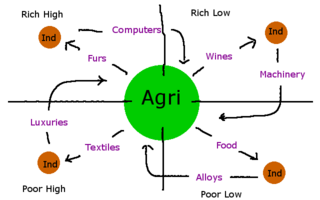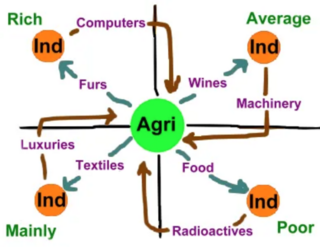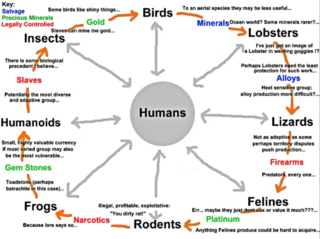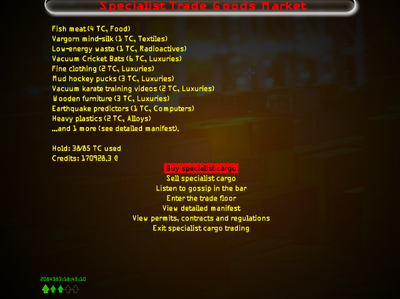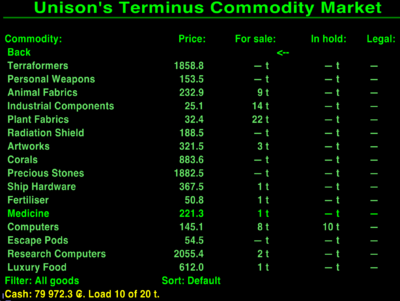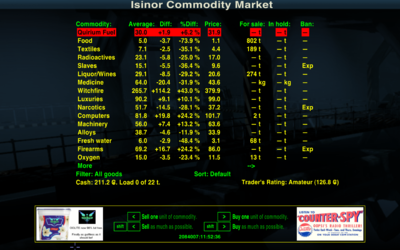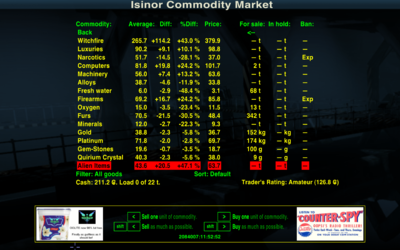Economics
| The two thousand star systems of the Cooperative once enjoyed a golden age of peace and prosperity, and perhaps the wealthiest of them can still pretend to. The trade ships that once safely travelled between planets now have to be well armed and escorted to fend off pirate attacks, from small-time criminals desperate for their next meal, to powerful robber barons extracting tithes from everyone who passes through their space.
The Cooperative's police force, concentrated near a few influential planets, can no longer maintain order. The mercenaries they hire for a few credits a kill are too few, too unreliable to do so either. And in the darkness between the stars, an old enemy lurks, fearless, perhaps waiting for order to collapse entirely. |
| (Oolite website, Introduction) |
Trade and economics, yes ... but greatly affected by piracy and by the decline of the Galactic Cooperative.
This page focuses on the wider issues of economics in the Ooniverse. For a discussion of how to succeed as a trader, see Oolite Trading.
Contents
- 1 The impact of Piracy
- 2 Trading Commodities
- 3 Critiques of Oolite's economics
- 4 Taxation
- 5 Investment
- 6 Ship pricing
- 7 Links
- 8 Economics OXP comparisons
The impact of Piracy
The second Elite novel, Imprint, starts off with the continual fighting off of pirates (the so-called "Knights Templars"). This is set some 20 or so years before Oolite - and things have only gotten worse since then.
Cim created a Space-sim simulator for analysing the relationship between pirates, traders & bounty-hunters in Oolite which you can find here: (Discussion is here).
Trading Commodities
Classic Elite - and thus the Oolite Vanilla game - has a grand total of 17 tradeable Commodities. There is a spectrum of 8 types of world to trade them between - ranging from Rich Industrial to Poor Agricultural.
The Oolite Reference Sheets which came with the game download (search for OoliteRS - stashed away in the entrails of your computer!) tabulates it all quite nicely. The Trading Goods Profit Table is worth looking at for a more comprehensive summary.
There are a number of OXPS which add individual commodities (see Links below), and also others which quite turn aspects of the vanilla game economy on their head.
Critiques of Oolite's economics
0) Daddyhoggy
- Daddyhoggy: The thing that always bugs me about Furs (and the trading in E/Oolite in general) is that sometimes trading in it sometimes just doesn't make sense. Just what are those lobstoids going to do with all those wolf pelts on their Rich Industrial planet beset by solar activity?
- It would be lovely to "fix" (without breaking or making too non-Elite or complicated) the trading in the game. Given trading is such a big aspect of the game, it's starting to look very tired. Daddyhoggy (2011)
Editor: There seem to be no fixes for this apart from Handwavium (2025)
1) Cim
- Cim: Let's assume a 1Tc barrel of Food contains 1000kg of food, or approx 500 person-days of food. A Boa will bring 125Tc, and lets say 2 or 3 arrive each day carrying food rather than other goods. So they're only importing enough food to feed a couple of hundred thousand people at most. We can probably pretty safely assume then that the Food cargo is generally luxury food, interstellar delicacies, and the like, and all planets are usually self-sufficient for basic food needs. The NPC bulk haulers (eg HammerHead) could raise it to a couple of million people, perhaps, which is still negligible.
- Cim (2012). Note that arguments exist over the definition of a TC: weight or volume?
Cim wrote 2 OXPs affecting Oolite's Economics. These do not radically re-invent it, but tweak it in certain areas.
- New Cargoes - emulates the Classic Elite lore, with trade in specialist items: Vargorn mind-silk & thrumpberry juice. Introduces 100 sub-variants of the regular commodities: mud hockey sticks! zero-gravity hockey sticks! Excellent profits only at one or two planets - but get your hockey variety right! Uses the lore and culture to generate new markets. Subscribe to a trade magazine with tips! Go on the Advanced Trading course at your alma mater, the Lave Academy!
- Risk Based Economy OXP - makes trade in dangerous systems more profitable, trade in safe systems less so. So less money initially.
Consideration of cim's critique
- Accepting cim's analysis thus leads to implications for population size. The population will be limited by the food supply. In a high TL system, there will be equipment allowing production of food on an otherwise barren planet. But in a low TL system...?
- The impact of a player's action on market prices will of course depend on the size of the market. Oolite markets seem very small, and one would expect player's actions to have a major impact. If the size of contract trade is factored in, the market size grows considerably, reducing this impact. If the markets on the planet surface are factored in too, then the market size grows immensely, and player's actions become irrelevant.
2) Redspear
Redspear dislikes the way that the most profitable items are almost always Furs & Computers. With Demand Driven Economy he prefers to make different commodities profitable in different economies, and thus creates a reliable profitable demand for luxuries in Rich Agriculturals, computers in Average Agriculturals & alloys in Poor Agriculturals. His oxp includes tweaks for population, economy size & tech level. Redspear prefers an enjoyable game to something which rigorously attempts to replicate reality too closely (and fails!).
Consideration of Redspear's critique
We are all after different things in our game. Redspear's approach certainly adds to the variety and the playability, and will enhance the immersion for many. But why are radioactives the main profit making import for Mainly Industrials while alloys make the profit in poor agriculturals? It may seem haphazard and illogical and for some players this will break the immersion.
3) Stranger
- Stranger: The Vanilla game descriptions seem controversial. Why does a Poor Agricultural system market have more food and soft goods at a lower price than a Rich Agricultural? We have no such controversy at the opposite end of the scale: a Rich Industrial market has more electronics and machinery at a lower price than a Poor Industrial market. It seems that "Poor Agriculture" is a logically flawed definition: it reflects the system's economic specialization, not the productivity level, nor the richness/poverty level!
- ...
- Oolite's economical model was inherited from the good old 8-bit 42 KB Elite. Compared with later space sims which feature hundreds of items in their goods lists, Oolite seems modest. You have only 17 goods – and only 14 goods for legal trade. Moreover, even this humble list is mostly useless. In reality you have an extremely limited subset of the most profitable items for your milk runs. Buy computers in industrial systems, sell in agricultural, buy alcohol & and/or furs, sell in industrial, repeat. Sometimes furs more profitable, sometimes alcohol, that’s all. Well, having 100 credits for start you’ll buy cheap food and sell it with good profit, but it is a very short period. Oolite is definitely NOT about economics. You have no reason to buy textiles if you have more cheap and more profitable food. Similarly, you have no reason to buy machinery if there is enough stock of the more profitable computers. And you have no reason to trade minerals, radioactives and alloys – of course, you can collect these items as bounty (if you have fuel scoops and enough free space in the cargo bay).
- There are at least three basic types of economy in other space sims, not just the Elite industrial/agricultural dichotomy. And, there are actually at least three groups of goods in Oolite, matching these basic types of economy.
- Agricultural goods (food, wine, textile, furs) – here production is not limited by TL, but is strongly affected by environment. It will be good to assume dramatic fluctuations of quantity and price for such items due to weather effects and other unpredictable events, affecting harvest.
- Raw materials (minerals, radioactives, gold, platinum, gems) – mining is affected by an unpredictable environment too, but to a lesser degree. In any case, industry needs buffer stocks of raw materials to allow uninterrupted production.
- Industrial goods (computers, machinery, alloys, luxury, firearms) – industry is a business with long-term planning, so it is the most stable sector of an economy: don’t expect significant fluctuations of quantity and prices. And high-tech goods will require a high enough TL.
- Slave and narcotics (and partly firearms of course) are a special case. This is illegal business, criminal, affected by random events, so quantities and prices for such items will be highly variable.
- (Stranger's introduction to SW Economy - but see also his essay, here)
Stranger seems unaware of Cim's critique above, instead arguing that industrials would have no agricultural goods for sale in their markets, etc.
Critique of SW Economy oxp
The creation of mining economies in agricultural worlds unable to support agriculture is incomplete. The mining worlds bear misleading agricultural icons. Their markets are agricultural with very low prices for the food that they cannot grow and must import. One suspects that the vanilla game code inhibits full implementation of this oxp.
4) Phasted
- Phasted does a similar thing to Stranger, but rather than introduce a tri-polar model and three new essential commodities, he focuses on the Vanilla game's bipolar model and makes it work more realistically.
- Proximity of neighbouring systems now affects prices as well as piracy! So one single industrial economy surrounded by a sea of agriculturals will have prices more similar to theirs.
- Prices fluctuate all the time as one watches, and buying and selling enhances this. Mistakes start to become expensive.
- Furthermore, "rich" and "poor" agriculturals now impact on their markets as rich and poor agriculturals (Stranger relabels them as Common, Strong & Extreme, treating their wealth as a separate quality). Rich agriculturals have more money to pay for computers than poor ones do (all other factors being equal). Poor agriculturals sell their produce for less.
- Markets may now stock 800TC or more of a commodity!
- Economies are given a comparative rating on the F7 page (data on "system") showing how the neighbourhood affects the local economy. The new rating is on the scale between poor agricultural (Agri 4) and rich industrial (Ind 4).
Critique of oxp
Faulty. After a while (often quite a while) the commodity prices tend towards 0. Also, there are no changes in quantities, just in prices.
A sixth radical OXP (Phkb)
You will see that there are three approaches. Cim looks at the game code and tries to explain the game model in an economic fashion (trade is mostly irrelevant - most planets fend for themselves (economic autarky) trading maybe just a few luxury goods. The trade which goes on may be too small to really matter. Redspear is concerned with playability, and wishes to make more commodities reliably profitable. Stranger & Phasted take another approach, looking at the way economics works and tweaking the game to fit.
These three authors thus wrote OXPs which enhance the economics of Oolite in quite different ways. There is a sixth OXP which works along lines similar to Cim's, Risky Business by Phkb, who sadly offers us no learned disquisition on economics! Risky Business aims to make Multi-Gov, Feudal and Anarchy systems more rewarding for traders, by tweaking prices on a few goods. Goods that are already over the average could be increased. Goods that are below the average could be reduced. Not all goods will be impacted at all locations. Phkb's newest version includes Cim's Risk Based Economy and allows you to choose between one, the other or both (you will need Library OXP to do so).
Commander Trigg’s ideas for a seventh OXP
I believe I've come up with a system that reduces the traditional milk runs and encourages commanders to trade with a bigger variety of commodities and in more systems. I've also come up with a reasonable explanation for the various price levels that fit into the ooniverse.
Unfortunately, I have 0 ability when it comes to writing any sort of script (I was so proud when I changed my keyconfig file so that the space bar fired my lasers).
Overview
The aim is to rebalance the trading system in order to encourage pilots to visit a wider range of systems and utilise a wider range of goods. This will need to reduce the profitability of poor agricultural – rich corporate “milk runs”.
There are two ways of manipulating what items are sold – price and availability. A low price will discourage pilots from selling goods at a specific system, while low or 0 availability will prevent these goods being purchased for a quick profit.
The basic type of item imported and exported by each system is based on the economy type and wealth level, with modifiers for government type. There is also a random element in list prices that may reduce / increase the profits from any trading run.
Economy types
Poor Agricultural
Poor Agricultural systems are a small step away from operating on a subsistence level and the population concentrate almost exclusively on growing food crops. Those few crops that aren’t used to fend off starvation are either sold for export or converted into potent fermented concoctions, very little of this brew makes it off-planet however. The average farmer has little need for the finer things in life and as such there is little demand for luxuries and computers. Machinery is highly sought after however, particularly tractors and harvesters which allow the farmer to make better use of his land. The more adventurous among the population head off into the wilderness on hunting expeditions to collect the pelts of the local wildlife and it is these furs that bring in the majority of the planet’s off-world credits.
Rich Agricultural
Factory farming is the order of business on these worlds. Crops are plentiful and this allows the farmer a relatively easy life and they can even indulge in the occasional luxury. A significant amount of the crops are converted into liquor and fine wines – which brings these systems the nickname of galactic vineyards. The most pressing need amongst the population is for computers which are used not only to manage the sprawling farmlands but also much-needed entertainment.
Poor Industrial
Picture a landscape of row upon un-ending row of grey factories, smoke belching towards the skies and you have a pretty good idea of what life is like on a poor industrial planet. These factories churn out large quantities of low-grade mechanical goods, alongside the radioactives that are the inevitable side-effect of the manufacturing process. There is a high level of alcohol dependency and drug abuse amongst the population as they attempt to escape the drudgery of their dull, uneventful lives
Rich Industrial
On rich industrial planets you will find a more skilled workforce, specialising in producing all the marvels of the modern age – everything from top spec computer systems to the latest in robot butlers. This climate has bred something of a “nouveau riche” culture, with the well dressed constantly in search of the latest exotic furs to stay one step ahead of the fashion police. With this culture comes a distinct lack of enthusiasm for the more “common” pastimes of drink and drugs, however a commander may find a willing market for the more unusual luxury items.
What this means:
Poor Agricultural systems sell furs and buy machinery
Rich Agricultural systems sell liquor and buy computers
Poor Industrial systems sell machinery and buy liquor
Rich Industrial systems sell computers and buy furs
A sample trading route would therefore be: Rich Agricultural, buy liquor – Poor Industrial, sell liquor and buy machinery – Poor Agricultural, sell machinery and buy furs – Rich Industrial, sell furs and buy computers – Rich Agricultural, sell computers and buy liquor.
Smaller profits would be available through cross-trading other items between the systems. Alloys and minerals are cheaper on agricultural worlds and can be sold to industrial worlds. Radioactives are easily available on industrial worlds and will be wanted as power sources on Agricultural worlds. Poor worlds produce luxury goods which are in demand on Rich worlds, while narcotics are wanted by poor worlds to alleviate the daily grind and can be purchased from the rich.
Average worlds have prices in between those of rich and poor, so provide a smaller profit margin than these systems.
Government types
Anarchy Slaves, narcotics and firearms have a lower price in anarchies compared to more stable systems. All prices tend to be slightly lower to encourage the player to take the risk of visiting these systems for a quick reward when they visit another system to offload their cargo.
Communist A good price can be found on mass-produced items (machinery/textiles depending on economy type) Liquor (in the form of vodka) tends to have a lower price while there is very little demand for luxuries and it is rare to find these available on the stock market.
Corporate The corporate systems will have a slightly increased difference in their import / export prices, which reflects the cut throat nature of business dealings on these systems.
Democracy As this is a fairly stable form of government I've used this as the basis for the price fluctuations that appear under the other systems.
Dictatorship Although prices remain fairly consistent with the norm, stock availability tends to fluctuate wildly in response to the erratic whims of the current ruler. Occasionally these whims only change when the glorious leader is deposed but given the frequency with which this happens the average trader can expect a completely different look to the market on their next visit. This level of variation can lead to healthy profits for the intrepid trader – along with a few wasted journeys
Others Special attention will need to be paid to the ConMart stations implemented by the Your Ad Here OXP and Rock Hermits OXP to ensure that prices stay in balance with the rest of the game and don’t drastically skew trading values. There may also be conflicts with the Bloomberg Markets OXP which would need to be addressed.
Profit Levels
Following the trade route suggested above, the commander could expect to make a profit of around 20C/t on the primary imports/exports and around 10 C/t on secondary imports/exports, although fluctuations and government types would influence this. There would also be a limited number of trade items at bargain prices (e.g. computers in a poor agricultural system) which were either left there by a poor trader or sold on by pirates after being scooped.
Notes
Economics was a book written by Aristotle in Classical Greece. He started analysing household accounts (Oikos Nomos - laws of the household) and moved on to look at the accounts of a Greek city state. Hence the term.
Note that of these 6 OXP's only New Cargoes, Demand Driven Economy & Stranger's SW Economy are available through the in-game Expansions Manager.
Also note that there are two quite different models of understanding how trade works.
The general one, where the F8 screen is understood to represent all the trading possible at the orbital station - with the sizeable F4 cargo contracts added in. This is taken to an extreme in the SWEconomy oxp where industrial planets will have absolutely no food/wines/furs for sale.
And then cim’s model based on an assessment of planetary needs and population leading to the conclusion that the planets are self-sufficient and that the F8 trade is mostly peripheral to the planetary economy.
Taxation
- Import and export tariffs - which are high on some worlds - are automatically added or deducted and this is reflected in prices shown (on the F8 screens) quote from Elite's Instruction Manual.
- Fines for illegality (piracy etc) are paid at the orbital stations.
- Other fines and taxes are added by OXPs.
- Income Tax (Diplomancy OXP by Commander Day) - also fines for visiting system stations without a visa.
- Fines for traffic offences (Safe Docking by Phantor Gorth).
- Fines for importing illegal goods (Smugglers by Phkb).
Investment
This is possible through OXPs
- Home System (Phkb) allows you to invest in your home system with corresponding benefits as you pump more money in
- Hermitage (Phkb) allows you to buy a Rock hermit
Ship pricing
BB Post by Lestradae (2009):
- I invested some thought in this lately and came up with the not completely new idea of letting the game calculate the prices based on the ship stats. That would have a lot of good consequences. For example, Uber ships would no longer be so Uber if you had to work really long to acquire them. And the quality of a ship would directly reflect into how difficult or easy it was to acquire.
- I have devised a suggestion how such a calculation could look like. It even produces rather fitting prices. Example results would be, for example:
- A flying strut: 276₢
- Adder: 29,500₢
- Gecko: 70,760₢
- Asp MkII: 120,960₢
- Cobra MkIII: 150,000₢
- Python: 177,650₢
- Tesoura: 432,000₢
- Fer-de-Lance (0.6 LS): 606,500₢
- Anaconda: 714,150₢
- Imperial Courier: 972,000₢
- Benulobiweed Firefly: 1,110,400₢
- Super Cobra: 1,622,000₢
- The Ultimate Uber Ship*: 345,610,000₢
- The Ultimate Uber Ship has all the highest stats that I found for any ship - but combined in one ship
The calculation would take a Cobra MkIII with a base value of 150.000₢ and then modify the price according to the stat differences in combination.
Basic Ship:
Cobra MkIII:
- Extended Cargo Capacity: 35 tons
- Speed: 0.35 LS
- Energy Banks: 4
- Missile Slots: 4
- Possible Equipment: All
- Manoeuvrability (Pitch/Roll): 1.5
- Gun Mounts: All 4
- Energy recharge rate: 4
- Price without Equipment: 150.000₢
Suggestion for price calculation:
- Cobra MkIII as standard with Standard Price: 150.000₢
- Extended Cargo Capacity: Price is raised/lowered 20%/10% per 20 additional/smaller Cargo Bay
- Speed: Price is doubled (each time)/lowered 20% per 0.1 LS jump up/down
- Energy Banks: Price is raised/lowered 20%/10% per additional/fewer Energy Bank
- Missile Slots: Price is raised/lowered 20%/10% per additional/fewer Missile Slots
- Possible Equipment: Price is taken down 10% per essential equipment piece not available
- Manoeuvrability (Pitch/Roll): Price is raised/lowered 20% per 0.5 additional/lower Pitch/Roll
- Gun Mounts: Price is lowered 10% per unavailable, 5% per reduced capacity Gun Mount
- Energy recharge rate: Price is raised/lowered 20%/10% per 1 additional/lower Energy recharge rate
- Price without Equipment is result of 150.000₢ multiplied by all multipliers!
Three example calculations might look like this:
Gecko:
- Extended Cargo Capacity: 3 tons (Price lowered 20% for non-existing cargo space) M=0.8
- Speed: 0.30 LS (0.05 LS down, price lowered 10% as slower) M=0.9
- Energy Banks: 3 (1 Energy Bank less, price lowered 10%) M=0.9
- Missile Slots: 4 (Price stays as is) M=1.0
- Possible Equipment: No MilSh, No ECC (Price lowered 20% as 2 essential EQ N/A) M=0.8
- Manoeuvrability (Pitch/Roll): 2.25 (Price raised 30% as 0.75 additional Pitch/Roll) M=1.3
- Gun Mounts: 1 (Price lowered 30% for 3 unavailable Gun Mounts) M=0.7
- Energy recharge rate: 4 (Price stays as is) M=1.0
- Price without Equipment: 150.000₢ * 0.7 * 0.8"2 * 0.9"2 * 1.3 ~ 47.2% ~ 70.760₢
Tesoura:
- Extended Cargo Capacity: 135 tons (Price raised 100% due to big cargo space) M=2.0
- Speed: 0.30 LS (0.05 LS down, price lowered 10% as slower) M=0.9
- Energy Banks: 7 (3 Energy Banks more, price raised 60%) M=1.6
- Missile Slots: 4 (Price stays as is) M=1.0
- Possible Equipment: All (Price stays as is) M=1.0
- Manoeuvrability (Pitch/Roll): 1.5 (Price stays as is) M=1.0
- Gun Mounts: 4 (Price stays as is) M=1.0
- Energy recharge rate: 4 (Price stays as is) M=1.0
- Price without Equipment: 150.000₢ * 0.9 * 1.6 * 2 ~ 288% ~ 432.000₢
Imperial Courier:
- Extended Cargo Capacity: 135 tons (Price raised 100% due to big cargo space) M=2.0
- Speed: 0.35 LS (Price stays as is) M=1.0
- Energy Banks: 8 (4 Energy Banks more, price raised 80%) M=1.8
- Missile Slots: 8 (4 Missile Slots more, price raised 80%) M=1.8
- Possible Equipment: All (Price stays as is) M=1.0
- Manoeuvrability (Pitch/Roll): 1.5 (Price stays as is) M=1.0
- Gun Mounts: 4 (Price stays as is) M=1.0
- Energy recharge rate: 4 (Price stays as is) M=1.0
- Price without Equipment: 150.000₢ * 1.8"2 * 2 ~ 648% ~ 972.000₢
- Oolite's default ship prices...nuts? (2010)
- Disembodied: "There's no sense risking damage or destruction to a very expensive ship"
- Cim (2013): With the current ship prices in Oolite, any pirate other than the entirely non-pragmatic would realise that the average act of piracy nets them a few hundred credits, selling a ship gets tens or often hundreds of thousands of credits, and the odds of surviving each fight are less than 99%. They therefore all sell their ships and retire in luxury.
- ...I personally just assume that the player is the subject of a giant practical joke and all the shipyard owners stick three extra zeroes onto the price tags when they see you coming... Cim (2013) - and see Cim's idea for a ship-price/maintenance oxp.
- Cim (2014): Basically the idea of piracy for profit is fundamentally broken because the value of any ship's cargo is insignificant next to the capital cost of the ship. (Malacandra) My guideline for this is to divide the in-game cost of the ship by 100 (or more). A decent ship will pay for itself in a few good trips, and then you'll be rich (but more likely dead); meanwhile light fighters and third-hand scraps/salvage can probably be picked up for a few hundred (most of which is the pulse laser).
- It also explains things like:
- - why you get pirate groups of three light fighters with pulse lasers, as opposed to two light fighters with military shields and lasers; also, why hardly anyone carries hardheads.
- - why the escape pod only costs 1000: it's mostly premium, not equipment; they expect a fair number of successful claims; it costs most of the price of an unequipped ship. Equipment insured for free is actually a fairly shrewd deal: anyone who can actually afford that equipment probably won't need to use the pod very often. (Cargo not insured is the same idea: for most of the people using the pods the cargo costs more than the ship)
- - why most of the combat potential of a ship is in its equipment Cim (2014)
- But now see Tsoj's recent post (2021).
Links
OXPs introducing new commodities
- Darkside Moonshine Distillery - Witchfire Whisky: Distilleries are only found in a few systems in each chart, often clustered in poor agricultural regions such as the Tortuga Expanse in chart 1. The price for Witchfire grows with distance from the distilleries making cross chart runs very profitable.
- Montanas Resource Pack 01 - Quirium Crystals - a luxury like gold, platinum & gemstones
- Fuel Tweaks - Quirium Fuel
- SW Economy - Fresh water, Oxygen & Medicine - note this OXP does a lot more than just introduce 3 new commodities!
- More Moolah OXZ - renames 10 commodities (eg. Luxuries becomes Cosmetics/Beauty) and adds Androids & Clones, Robots, Live Animals, Leather Goods and Medicines
Loans
- Bank of the Black Monks - the Order of the Black Monks of Saint Herod
- Bank of the Knights Templar - in DGill's new Feudal States Tibecea OXP - loans for managing your estate
- First Finance (downloaded 77 times) by Ocz: Beginning the game with a loan to pay off - the loan! (2014)
- Loan Repayment (downloaded 86 times) - the lenders! by Ocz as above (2014)
Savings
- Witch Bank - takes deposits
OXPs with a broader economic scope
- Risk Based Economy OXP - by Cim. Makes trade prices depend on government as well as economy (1.77).
- Risky Business - by Phkb. As above. See BB discussion and comparison with Cim's above here. Note that Phkb has been working on combining the two (here - 2021).
- Demand Driven Economy - by Redspear. Gives each of the 8 system economies one profitable import, with tweaks for population, economy size & tech level, thus breaking away from the Computers-Furs profit model.
- SW Economy - by Stranger (2012-21). Introduces trade in medicine, water & oxygen. Totally alters trade & prices to bring in some realism. Planet size & economy size are now also relevant to a planet's production, affecting quantities on offer. Attempts to introduce a 3-polar economy (agricultural / mining / industrial).
- Real-Life Economics - by Phasted (2012-4). Fluctuating markets which react to your actions. Local solar systems also affect prices. Slightly buggy.
- New Cargoes - by Cim 2014. Introduces 100 sub-variants of the regular commodities.
- New Cargoes Trading Advice - transcript of the Advanced Trading course at Lave Academy
- BlOomberg Markets - by Ramirez & Svengali 2010-19. News flashes and market changes. Needs GNN (for news flashes).
- Hermitage - by Phkb. A totally different take. You run a rock hermit and try to make a profit by mining, trading & attracting customers with black markets & bars...
OXPs doing other things but impacting on Economics
- Diplomancy OXP - Taxes! wars! citizenship! the need for Visas etc. by Commander Day (2017+)
- Smugglers - black markets, bribes & smuggling compartments (2015+)
- Recession.oxp by JohnSmith (2006) - an escort mission, but set against an economic Recession. This oxp is Broken.
- SOTL Altmap: 40 new commodities, new economies, new governments. A new game using the Oolite engine by Cim. (2017)
Interesting but broken/unfinished OXPs
Note that all relevant oxp's would have been broken when Oolite v.1.81 replaced the old unwieldy commodities.plist & illegal_goods.plist with the new Trade-goods.plist (2014). If they have not been updated, they may still be broken.
- New Deal - by Vincentz (2015). Unfinished. 4 new economies (Agricultural, Industrial, Mining & Financial) each divided into developed and primitive versions (with snazzy icons!).
- Switeck's Shipping v0.5 OXP (2010) - AI, Economy, and Ship changes. Again, probably broken now.
- Ship's Accountant OXP - for devotees of the double-entry systems! (by Commander Walbrigg, 2013).
BB Discussions
- Cim's seminal discussion on economics for v.1.82 (2014-5)
- Another Cim inspired discussion (2013): Piracy, trade, AI roles, Market prices (Sat Aug 03, 2013 9:29 pm for a bit; Sun Sep 01, 2013 2:57 pm for a bit)
- galcop's BB Thread (2013) - why the laws are the way they are, Governments, Economics & GalCop
- Cim on the Budget of the Galactic Navy (2012)
- The 127 Limit (2006-9)
- Commodity sub-types (2015+): note Redspear's powerful defence of the Oolite trade model.
- Strangers Roolite Essay on Economics & the Oolite trade model (2014, posted 2021)
- Yes, but how many credits is that? (2013) - Develops into discussion of ₢:$:£:€ exchange rates
- Speculation on the economics of Biodomes/Orbital stations
- BB Thread comparing Maesin (Poor Agricultural Anarchy, TL: 1, 0.8 Billion Small Harmless Furry Rodents with a Productivity of 768 M₢) with Ceesxe (Rich Industrial Corporate, TL: 15, 6.4 Billion Fierce Bony Birds with a Productivity of 56,320 M₢): population 8x as big but GNP only 73x bigger! (2007-18)
- Thinking about Planet Income classification (2015): introducing an information/service economy
- Should Oolite have a financial system? (2014)
- More competition in the banking sector (2009)
- One idea, appearing constantly in the threads above is that the regular non-contracted trading makes little sense. An opposing view will be found here: Spara (2016)
Role of different species
- BB thread on the possible relevance of species (2013)
- Redspear's analysis culminating with an alternative economic model based on trade between species (2017)
Game issues
- Should running costs be much more expensive and frequent? (2006)
- Tax OXP? thread (2012)
- Problems of having too much money (2015)
- Thought experiment: no currency (2017)
Other Discussions
- Pioneer game's ideas page on economics - has some useful links such as:
- Star Citizen Economy Economics as a generator for gameplay missions (2013)
- This video clip is good, but lacks context (see how cim's analysis of context in Oolite above can totally change one's understanding of oolite trade). Is the piracy affecting missile production focused on disrupting it - or is it just general piracy, which in this case impacts adversly on the company? This will surely affect the company's response. And, if piracy is bad, will not production move to where the resources are, to prevent disruption of supply chains?
- Interstellar Trade: A Primer Costs of trade, costs of a navy. (2001)
- The theory of interstellar trade Academic economics paper (Prof Paul Krugman, 1978).
Economics OXP comparisons
| Risk-based Economy | New Cargoes | Risky Business | SW Economy | Real-Life Economics | Demand Driven Economy | |
|---|---|---|---|---|---|---|
| Author | Cim | Cim | Phkb | Stranger | Phasted | Redspear |
| Functionability | v.1.81+ | v.1.90+ | v.1.81+ | v.1.82+ | needs fixing | v.1.79+ |
| Redefines systems economically | No | No | No | Yes | Yes | No |
| Adds new commodities | No | Yes | No | Yes | No | No |
| Breaks away from Furs/Computers as most profitable trades | No | Yes | Yes | No | No | Yes |
| Piracy (government type) affects prices | Yes | No | Yes | No? | No | No |
| Hub connectedness affects prices | Yes | No | No | No | Yes | No |
| Economy size affects prices/quantities | No | No | No | Yes | No | Yes |
| Planet geography affects prices/quantities | No | Yes-ish | No | Yes | No | No |
| Prices/Quantities vary dynamically | No | Yes | No | No | Price only | No |
Note: Phkb has updated New Cargoes (v.2.0) and it is finally compatible with Smugglers. New Cargoes dovetails with the information given to you on the F7 screen by the Famous Planets OXP. And there is also a tutorial for it (New Cargoes Trading Advice).
Note: Phkb has come up with a brand-new version of Risky Business which includes Risk-based Economy (you can choose to activate either or both using Library OXP). It also needs his auxiliary oxp - Market Script Interface - to operate.
This table also ignores some brilliant oxps which introduce a focus on just one aspect of economics.
Black Markets
This table currently excludes Phkb's Black Market & Smugglers OXPs. They too have a major affect on trade and economics, but are not directly comparable with the above, since they work on prohibiting trade (thus encouraging smuggling and a black market) which then impacts massively on pricing.
- Black Market - Adds black markets to most Rock Hermits and some other stations (contains much of what was in the original Smugglers OXP)
- Smugglers - Makes any commodity potentially illegal to import in various systems, and adds equipment and contracts for those interested in smuggling goods outside normal legal channels.
Geography
- BlOomberg Markets creates sudden changes in commodity prices which are geographic & time-limited in effect.
- Darkside Moonshine Distillery introduces distance from production as an affect on price. This is done with more subtlety than BlOomberg Markets' affects.
Dynamic trade
- In System Trader makes in-system trading more realistic, with changing prices and quantities depending on local traffic.
Loans
- Black Monk Monastery allows you to take out loans
- First Finance OXP creates the loan that allowed you to buy your spaceship
Prices
- Commodity Markets OXP replaces the single price of each commodity with a buy/sell spread (of 4-10%).
Quantities
- Random Market Quantities by Astrobe (2016) - reduces amounts on sale (best added with extra stations present)
Taxes
- Diplomancy OXP introduces taxes (and lots of other stuff too).
Other
- Cargo Space Correction OXP - Phkb's auxiliary OXP to sort out conflicts between other cargoSpaceCapacity-script OXPs and the vanilla game
- Market Script Interface - Phkb's auxiliary OXP to sort out conflicts between other market-script OXPs
- New Deal - an unfinished OXP with a new trading model for Oolite
Reference
- Oolite Trading for information and strategies
- and also: Trade (classic Elite) & Trade (FE2/FFE)
- Career Options - Trader for more detail and useful OXPs
- Trading Goods Profit Table - a useful summary of Vanilla game commodity profits
- Commodity Calculator for calculating commodity prices for OXP markets (uses legacy script from Oolite v.1.0 - v.1.79)
- BB thread on commodities.plist for programmers (2007-11)
- Deterministic Oolite - randomness & markets - vaguely related musings (2017).
- Powers and Organisations - analysis of government types
- Law
- TL (Technology Level)
















